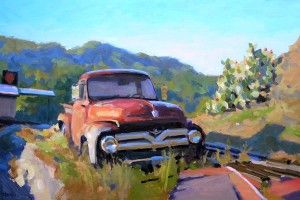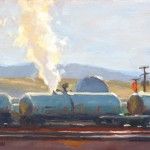Tim Horn captures the light of everyday moments in his nostalgic art
By Bonnie Gangelhoff
Red-roofed cottages perched by the sea, pastel-colored laundry pinned to a backyard clothesline, rusty Ford trucks sitting in fields on the fringes of small-town America—there is a certain nostalgic art thread running through paintings by Northern California-based artist Tim Horn. In fact, his scenes appear to spring from another era, focusing on ordinary moments and optimistic slices of life that others might ignore. “I liked Tim’s work the minute I saw it. The paintings are bright, cheerful, and with fun subject matter,” says gallery owner Nancy Dodds, who has represented Horn for five years at her namesake gallery in Carmel, CA. “His work also has a great quality of light that my clients can relate to.”
As this story was going to press, Horn was on his way to the California Art Club’s annual Gold Medal Juried Exhibition at the Autry National Center in Los Angeles. One of his paintings in the show, DOUBLE TAKE, is a quintessential example of his visual take on contemporary life, a work that depicts a carefree young woman pedaling a bike down a sunlit street past a shiny, silver Airstream trailer. The inspiration for the painting, Horn says, was a street scene in Missoula, MT, where he was participating in a paint-out last summer. “Missoula turned out to be the perfect place for my kind of subject matter. Not too fancy, a little rustic, and rundown on the edges with a beautiful backdrop of mountains and big sky,” he explains. “I ended up making a few adjustments, including leveling the tilted trailer, softening the presence of the big stove in the driveway, and putting a straw cowboy hat on the figure to help separate her from the background. But otherwise, the scene is exactly as I saw it.”
In his former life, Horn was a successful graphic designer. In 2006 he closed the doors on his lucrative business in San Rafael, CA, and turned his attention to a full-time career in fine art. Since then he has won a number of Artists’ Choice awards at shows such as the Napa Valley Art Festival and Sonoma Plein Air, and in 2009 he received an award of excellence at the Oil Painters of America National Juried Exhibition. A year later he was included in Southwest Art’s annual “21 Over 31” feature story.
Horn’s paintings have a distinct California feel to them, in spite of the fact that he is not a native son. He moved to the Golden State in 1992 after working in New York City for more than a decade. Before that, he spent his formative years in Yellow Springs, OH, a place he describes as a small town surrounded by cornfields and pig farms. But even as a youngster he had an interest in art. His future career choice was sealed, Horn says, during his sophomore year in high school, when a graphic artist visited his art class and showed them his portfolio. Horn’s family had limited resources, so, when he decided on art school following high-school graduation, he was overjoyed that the prestigious Cooper Union for the Advancement of Science and Art in New York City accepted him. Cooper Union was not only a great school, Horn points out, but it was free.
After earning a degree in graphic design, he landed a succession of jobs with top clients and firms in the city, including a hip, boutique firm that designed, among other things, album covers and posters for the band Talking Heads. But Horn always took art classes in his free time, immersing himself in everything from photography to lithography. “I was passionate about design all through school and beyond, but working as a designer left me somehow creatively unfulfilled, which led me to a string of continuing-education classes in art,” Horn says.
Eventually he was ready for a change of scenery, and so, after 11 years in New York, Horn pre-empted a future midlife crisis, bought an Italian sports car—a red convertible—and set out on the back roads of America. Final destination: San Francisco, where he not only set up a design firm but eventually continued his art education with figurative and landscape painting classes. A turning point in his career arrived one day in 1997. While training for a cross-country bike ride, he happened by chance on an outdoor painting class taught by Stanley Goldstein. The idea of participating in a class like that captured his imagination, and he decided to join the group, which met weekly in China Camp, an old fishing village dotted with dilapidated buildings and weathered boats. About two years later, he started supplementing those classes with ones taught by painter Randall Sexton.
Today Horn calls Fairfax in Marin County home. The small community north of San Francisco, with a population of about 7,400 people, has been described as an artsy, family-friendly place that looks as if it never left the ’60s because of all the organic food stores and “green” businesses. For Horn, the small-town atmosphere is at times reminiscent of Yellow Springs. Occasionally he even finds a few old cars around town to paint, like the one depicted in MANOR FORD. But mostly he heads to the nearby towns of Petaluma, Point Reyes Station, and Tomales, or to Potrero Hill in San Francisco, for inspiration.
As a stay-at-home dad, however—his wife, Lili, works full time—he sometimes finds it hard to stray too far from Fairfax. He takes his two young sons, Nate and Reeves, to school, cooks, grocery shops, and even regularly hangs the family’s laundry to dry on the backyard clothesline. Such occasions, however, are not wasted time in terms of creating art. For example, as he was performing the usual clothes-hanging chore recently, he was struck by the visual appeal of the ordinary sight—the colors of the pastel shirts, puffed up by the wind and beautifully backlit. The task soon turned into a painting that became part of a series. “What I like about CLEAN LAUNDRY, NO. 3 is that drawing is not a critical factor in the success of the painting,” Horn says. “It’s about light, color, and that translucent quality. Plus it’s a historical document of my family. One of my sons’ shirts, one of mine, and one of my wife’s is in the painting.”
The spontaneity of portraying such an everyday moment is what Horn relishes most in the creative process. Drawn less to a traditional way of working, he says honoring the unexpected or random inspiration is an essential element in his work, and he values “the unexpected” in composition choices as well. This might explain why he is drawn to paintings by California- based photo-realist Robert Bechtle, who doesn’t mind placing a telephone pole smack in front of a magnificent lighthouse. Another, more traditional painter might prefer to leave out such ubiquitous but not-so-charming elements of modern-day life.
Remak Ramsay, a retired stage actor and an avid art collector from New York, owns works by Jacob Collins and a number of other Water Street Atelier artists as well as five paintings by Horn. Ramsay doubts that five will be enough, though. “Tim Horn not only has fine compositional skills and great color sense, his brush marks are direct and clean and powerful. No mushing around and mixing it too much together and making it turn muddy,” he says. “Tim’s work is clear, clean, honest, and forthright as really good American art usually is. He obviously loves light and loves paint—sometimes like a kid likes icing on a cake—and it shows.”
While Horn may be best known for his sunny California scenes, he also depicts what he calls “life on the edge of town.” This visual concern, he believes, stems from his childhood in Yellow Springs, which was not “fancy.” Thinking back, Horn says if he were to stand in the front yard of his boyhood home and throw rocks in all four directions, two of them would land in cornfields, the third in an empty lot, and the fourth rock in a cemetery where he used to play.
He also notes that as a youngster he rode his bike everywhere—on his paper route, to school, to soccer practice, to the grocery store, and to catch tadpoles and frogs with his brother. “Back alleys were always more interesting than Main Street,” Horn says. And when it comes to the subject matter for his paintings, he finds that fact to remain true today. “I want people to see or notice the poetry in the small moment where the faded turquoise paint and the rust and the sparkle on the chrome all come together,” he says. “I want them to see how the play of light and shadow and translucency can make a beautiful instant out of something as mundane as laundry hanging on a line.”
representation
Knowlton Gallery, Lodi, CA; Greenberg Fine Art, Santa Fe, NM; Dana Gallery, Missoula, MT;
Nancy Dodds Gallery, Carmel, CA; Gardner Colby Galleries, Naples, FL; Donna Seager Gallery, San Rafael, CA; www.horndesign.com.
Featured in the June 2012 issue of Southwest Art magazine–click below to purchase a copy:
Southwest Art magazine June 2012 digital download
Southwest Art magazine June 2012 print edition
- Tim Horn, Two Fords, oil, 9 x 12.
- Tim Horn, Swimmy, oil, 8 x 10.
- Tim Horn, Out of the Blue, oil, 8 x 10.
- Tim Horn, One White Boat, oil, 11 x 14.
- Tim Horn, Not a Through Street, oil, 12 x 24.
- Tim Horn, Manor Ford, oil, 30 x 40.
- Tim Horn, Light Keeper (study), oil, 8 x 10.
- Tim Horn, Fort Mason Cottage, oil, 9 x 12.
- Tim Horn, Edge of Forever, oil, 8 x 10.
- Tim Horn, Double Take, oil, 24 x 30.
- Tim Horn, Dappled Chevy, oil, 11 x 14.
- Tim Horn, Clean Laundry, No. 3, oil, 8 x 10.
- Tim Horn, Chadwick House, oil, 9 x 12.
MORE RESOURCES FOR ART COLLECTORS & ENTHUSIASTS
• Subscribe to Southwest Art magazine
• Learn how to paint & how to draw with downloads, books, videos & more from North Light Shop
• Sign up for your Southwest Art email newsletter & download a FREE ebook























